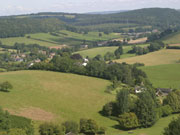 |
 |
 |
 |
At the time of Jesus' birth members of the local Celtic tribe, probably the Silures, were frequent travellers along the tracks that climbed up to their encampment on Chase Hill. These people were skilful metal workers, using iron ore and a plentiful supply of wood from the forest for forges.
A town called Ariconium was known to exist from a contemporary description of its distance from Glevum (Gloucester) and Blestium (Monmouth), but its precise location was not known until the late eighteenth century when Thomas Hopkins Merrick of Bollitree made the first discoveries.
An excavation carried out by G H. Jack in the 1920s uncovered part of a road 8-12ft. wide, running southwards. He also excavated furnaces and found areas of slag, which suggested that Ariconium developed as an important smelting centre rather than as a garrison town. It has even been described as a sort of "Roman Birmingham."
100 AD
Ariconium flourished for the next two hundred years or so. Under Roman law life was relatively peaceful compared to the times that had gone before and the Dark Ages that were to follow.
Towards the end of the fourth century the legions began their withdrawal from Britain. A breakdown in law and order followed and towns like Ariconium were abandoned. There is a local legend telling of an earthquake that destroyed the town but it is much more likely that it was allowed to fall into ruins.
600 AD
In the late sixth century Saxons from northern Europe invaded west Gloucestershire and established farming communities, market towns and villages, many of which survive to this day. Weston, Anglo-Saxon for "settlement to the west" as opposed to Aston (Ingham) "settlement to the east" probably refers to its position in relation to Ariconium. It is likely that the settlers plundered the neglected town for materials to build their own homes and farmsteads in the more sheltered areas.
Despite the many hazards faced by travellers at that time, missionaries of the Celtic church introduced the Christian faith to those parts by the middle of the seventh century.
800 AD
For generations these borderlands were farmed in relative peace, though the continuing threat of raids prompted Offa, the Saxon king of Mercia, to build his famous dyke. In the ninth century Alfred of Wessex successfully held the Danish invaders at bay. A local legend tells of a battle long ago and there are three fields in the parish, which bear the names "Kill Dane Field", "Kill Dane Meadow" and "Kill Dane Orchard."
These are edited extracts from “Weston-under-Penyard”, and are reproduced by kind permission of David Herrod & the Weston-under-Penyard Millennium Celebration Committee.
© The Weston-under-Penyard Millennium Celebration Committee 2001